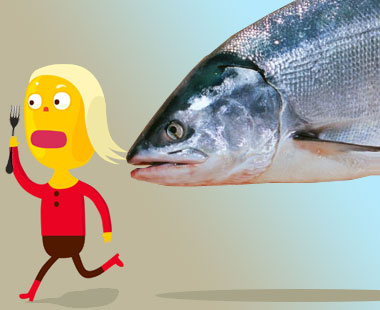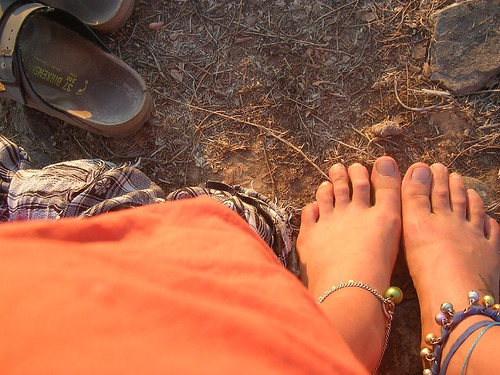Send your question to Umbra!
Q. Dear Umbra,
I love Birkenstocks, but what’s the deal with Birko-Flor? A leather alternative, sure. But they’re vinyl, and I believe vinyl is a four-letter word in Grist world. Would I be better off just sticking to traditional leather-upper Birks?
Jennifer
Brooklyn, N.Y.
 Heart and sole. Photo: pi?A. Dearest Jennifer,
Heart and sole. Photo: pi?A. Dearest Jennifer,
Birkenstocks: Not just cool in the ’70s. I happen to know several 20-somethings who rock the ‘stock, and it goes without saying that Seattleites love any sandal they can pair with Smartwool. That you live in Brooklyn is only further testament to Birkenstocks’ enduring hipness.
Did you know that the cork in Birkenstocks soles is salvaged from the wine-bottle cork production process? I did not (and now feel justified in drinking a glass of vino the next time I don my 10-year-old Birks). That is one of the fun facts I discovered while researching Birko-Flor, which was not around when I acquired my pair.
According to the company, Birko-Flor is a fabric “made of acrylic and polyamide felt fibers.” The good news: It’s waterproof and cheaper than leather. The bad news: Acrylic is essentially a plastic. It’s made mostly of polyacrylonitrile, which is a vinyl polymer, so you’re right — our nemesis vinyl rears its head once again. (Here’s another tangential fun fact for you: Back in the day, there were problems with acrylic fabrics pilling, and guess who invented a chemical to fix that? Our friends at Monsanto.)
So yes, although faux-leather shoes are marketed to vegans and others trying to be Earth-conscious, you have the toxins created in vinyl production to consider. (I wrote once before on leather versus pleather shoes, and many of you wrote insightful comments.) And traditional leather shoes, as we know, are incredibly resource-intensive. “From start to finish, the amount of energy required to create a leather hide is 20 times greater than what’s used to produce a synthetic material,” says Ecouterre. Ouch. What’s a soleful person to do?
If you don’t want to have to choose between clean air and animal welfare, Moo Shoes is one vegan shoemaker that purportedly doesn’t use vinyl or PVC in its animal-free kicks. What about recycled shoes? Simple Shoes boasts using recycled and sustainable materials like old tires, recycled inner tubes, hemp, and coconut. Any new shoe will take a toll on the Earth and air and water (unless it’s one you weave together out of your old yard scraps), but at least those made from recycled material may have a smaller footprint (pun intended).
As always, I must urge you to think carefully before buying. Shoes go out of style quickly and end up in the landfill, like so many of our things. Our culture (especially its ad industry) perpetuates a picture of easy-breezy shopping — painlessly picking up shiny fun things that will make our lives happier and make strangers like us more. Shopping is American.
Or is it? Our things are shipped from faraway places with working conditions we try not to think about. So we should buy less, buy quality, and repair what we’ve got. As commentor rraimo pointed out, there isn’t enough emphasis on fixing our duds or having them mended. It ain’t glamorous, and you probably won’t get a rush from it or a branded shopping bag declaring your social status, but you are lowering waste and supporting a local industry. Cobbler — not just a tasty dessert.
Fixedly,
Umbra



